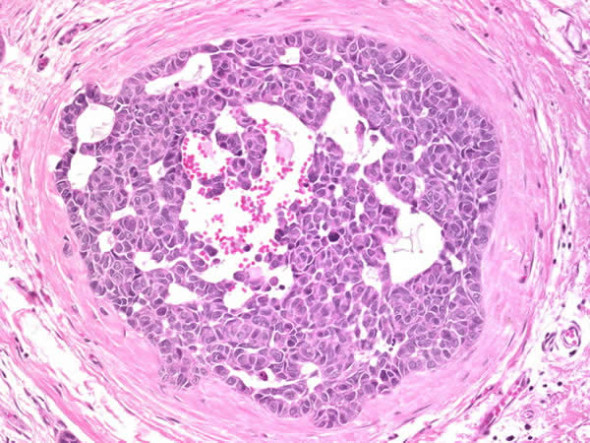Pathologists Often Disagree on Biopsy Findings
 I thought we covered this more than a year ago but a recent study published in the Annals of Internal Medicine with an accompanying editorial and an article written by Troy Brown, RN on Medscape, there has been some additional dissection of the data from what is being called the “B-path (Breast Pathology) Study”.
I thought we covered this more than a year ago but a recent study published in the Annals of Internal Medicine with an accompanying editorial and an article written by Troy Brown, RN on Medscape, there has been some additional dissection of the data from what is being called the “B-path (Breast Pathology) Study”.
Many readers will recall that in the previously published Breast Pathology (B-Path) Study, researchers found that, when looking at a single slide from each of 240 cases, pathologists gave the same diagnosis as a consensus panel of three expert pathologists 75% of the time. And there were some issues amongst experts when the cases were reviewed independently.
Although these data were interpreted by some readers (and the media) as meaning that a woman had a 1 in 4 chance of having an incorrect diagnosis, Dr. Joann Elmore from the University of Washington School of Medicine and Fred Hutchinson Cancer Research Center, Seattle and colleagues emphasized that was not the case. The participating pathologists had higher rates of agreement with the panel on samples that were benign without atypia or invasive cancer, and those are by far the most common sample types on a population level.
This results from the study of the data showed, “Overall, if 1 representative slide were used per case, 92.3% (95% CI, 91.4% to 93.1%) of breast biopsy diagnoses would be verified by reference consensus diagnoses, with 4.6% (CI, 3.9% to 5.3%) overinterpreted and 3.2% (CI, 2.7% to 3.6%) underinterpreted. Verification of invasive breast cancer and benign without atypia diagnoses is highly probable; estimated predictive values were 97.7% (CI, 96.5% to 98.7%) and 97.1% (CI, 96.7% to 97.4%), respectively. Verification is less probable for atypia (53.6% overinterpreted and 8.6% underinterpreted) and ductal carcinoma in situ (DCIS) (18.5% overinterpreted and 11.8% under interpreted).”
And goes on to recognize that there are limitations and “Estimates are based on a testing situation with 1 slide used per case and without access to second opinions. Population-adjusted estimates may differ for women from other age groups, unscreened women, or women in different practice settings.”
The authors conclude that “This analysis, based on interpretation of a single breast biopsy slide per case, predicts a low likelihood that a diagnosis of atypia or DCIS would be verified by a reference consensus diagnosis. This diagnostic grey zone should be considered in clinical management decisions in patients with these diagnoses.”
In an accompanying editorial by breast cancer specialists in pathology and oncology at UC-Davis and UCSF, the authors conclude the study “reveals problems with the precision and accuracy of the current gold standard for breast cancer diagnosis” and “The data show significant interpretation discordance, with a tendency toward ‘overcalling’ the risk level of disease. Diagnostic uncertainty implies a need to revise our classification of proliferative lesions to minimize confusion, more appropriately reflect risk, communicate uncertainty, and minimize unnecessary treatment. The [study] further emphasizes the need to redefine ‘cancer’ and avoid using the term for lesions that are not destined to kill the patient.”
This means I have a 50% chance of overcalling “atypia” and nearly 20% of overcalling DCIS with approximately 10% between the two for undercalling.
So what are those of us in the trenches suppose to do? Get a second internal opinion? Outside reference opinion? Consensus conference all these cases? How many of you do this in your practice today? Either peer review with at least one other internal pathologist or refer “atypical vs. DCIS” for second/expert opinion?
It seems to me while the study only used single slides with an “enriched” data set of atypical and DCIS diagnoses, with some concordance among experts as to “ground truth” diagnosis, we need better diagnostic criteria that is reproducible and clinically relevant for appropriate management.
I gather a working group or committee composed in part, of breast pathology experts, clinicians and epidemiologists is in our future to relook at “gold standards” and diagnostic criteria that are more reproducible and clinically significant.
































